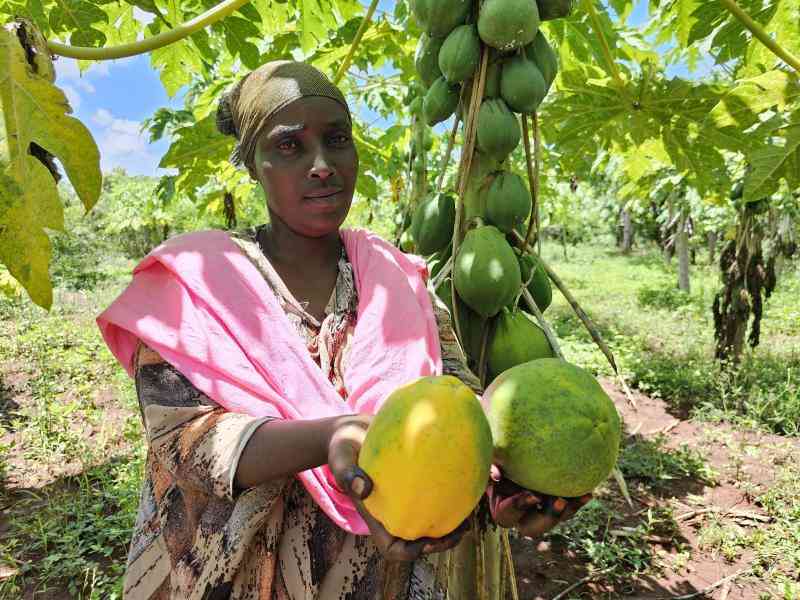
Some of the items I am likely to gift people this season are clothes, shoes, handbags, belts, or books. Most will be new, hence wrapped. A most likely scenario in my village is the wrappings flying past our fence to distant neighbours’ homes. Before you know it, a goat or cow will be endlessly chewing a piece of plastic bag somewhere, or a farmer struggling to pull one from their cow’s throat. We forget about waste management as soon as we leave our city houses.
What’s with gift wrappings though? According to a 2017 study from Zero Waste Canada, the country collects over 500,000 tonnes of waste from gift-wrapping and shopping bags yearly. Most are never reusable or recyclable. Back home, as the festivities unfold, the anticipation to embrace cherished moments is palpable. Yet, amidst the unavoidable desire to decorate, wrap gifts, send cards, or unwrap new acquisitions lies a looming shadow: our impact on the environment.
The holidays, which witness a lot of traditional marriages, weddings, initiations, and other celebrations, come with a burning desire to buy consumer goods and services, to mark the season and belong. Sometimes this causes January to be longer, though we regret not for the joy and togetherness experienced during the festivities. If anything, you only live once!
In all these, however, the ensuing environmental degradation as a result of mounting waste from increased production and consumption is undeniable. Right from the decorations in urban areas, Christmas trees, displays in shops and homes, bright lights, excessive packaging of gifts, and littering, there ensues carbon emissions, resource depletion, and environmental degradation.
Increased travel during this period, whether by air or motorised means, and the likely traffic jams, as witnessed on Mombasa Road recently, with many engines running but vehicles moving minimally, mess with air quality. The processes and activities that take place in the months preceding December may also involve uncouth food-producing methods, including for chicken, whose demand increases at this time. The unavoidable intensive farming practices, and massive food wastage, all happen at the expense of the environment.
According to a Stockholm Environment Institute paper, “Our total consumption and spending on food, travel, lighting, and gifts over three days of Christmas festivities could result in as much as 650kg of carbon dioxide emissions (CO2) per person”. This, the paper says, is “5.5 per cent of our total annual carbon footprint.”
But, can’t people just have fun? Embracing sustainability during festive seasons can never take away the merriment. You can opt for eco-friendly decorations, reusable and recyclable packaging, or even better, creative and reusable wrapping solutions, and significantly reduce waste and environmental degradation. It also requires fostering a mindset shift from “buying because everyone is buying” to “conscious consumption”, which will make a huge difference in your spending and leave you with something to weather the often challenging 50-odd days of January. Education and awareness play pivotal roles. Engaging in conversations, raising awareness about the impact of festive practices, and championing sustainable alternatives can influence collective behavior positively.
The nexus between festive celebrations and climate change warrants introspection and appropriate action. By redefining spending around December, embracing mindful consumption, and proper waste management, we can weave celebrations that honour both our cherished moments and the well-being of Mother Earth.
A more responsible, eco-conscious celebration is possible!
The writer advocates climate justice. [email protected]
 The Standard Group Plc is a
multi-media organization with investments in media platforms spanning newspaper
print operations, television, radio broadcasting, digital and online services. The
Standard Group is recognized as a leading multi-media house in Kenya with a key
influence in matters of national and international interest.
The Standard Group Plc is a
multi-media organization with investments in media platforms spanning newspaper
print operations, television, radio broadcasting, digital and online services. The
Standard Group is recognized as a leading multi-media house in Kenya with a key
influence in matters of national and international interest.
 The Standard Group Plc is a
multi-media organization with investments in media platforms spanning newspaper
print operations, television, radio broadcasting, digital and online services. The
Standard Group is recognized as a leading multi-media house in Kenya with a key
influence in matters of national and international interest.
The Standard Group Plc is a
multi-media organization with investments in media platforms spanning newspaper
print operations, television, radio broadcasting, digital and online services. The
Standard Group is recognized as a leading multi-media house in Kenya with a key
influence in matters of national and international interest.









